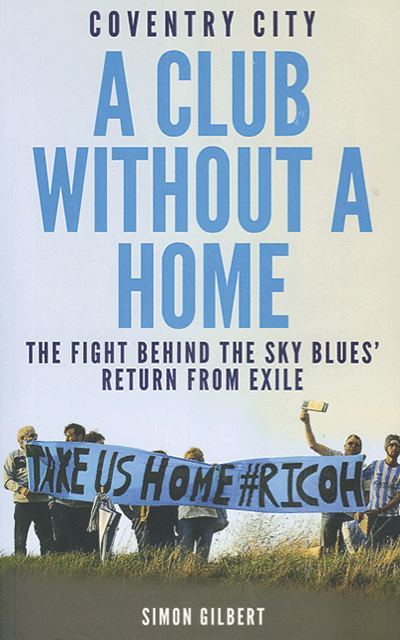
Coventry City – The fight behind the Sky Blues’ return from exile
Pitch Publishing, £12.99
Reviewed by Neville Hadsley
From WSC 361, March 2017
Buy this book
In 2013 the owners of Coventry City – a hedge fund called SISU – took the extraordinary decision to move the club out of their home of eight years, the Ricoh Arena, and play their home fixtures at Sixfields in Northampton 34 miles away. Simon Gilbert’s book, which is subtitled “The fight behind the Sky Blues’ return from exile”, chronicles the events that led up to that decision – right from the move from Highfield Road in 2005 and the aftermath when Sky Blues fans find themselves back in the stadium built for their team but as tenants of rugby club Wasps.
This labyrinthine tale is part of a bigger story of decline which has seen the club fall from a Premier League team to homeless shell of a club scrabbling about at the bottom of the third tier. Gilbert, however, keeps his focus on the shenanigans surrounding the Ricoh. The stadium began as the club’s project but, with the money from the sale of their old stadium Highfield Road having seemingly evaporated, the club had to beg the city council to build it.
A local journalist, Gilbert’s book at times reads like a lengthy piece in the business section of a mid-market paper. This is almost inevitable since the tale is a tortured one of financial intrigue, legal argument and the collision of private interest and local politics.
That all sounds like it could be as dry as a desert but Gilbert’s style is clear and highly readable, and because he talks to the key figures there’s a lot of detail which enlightens this sorry story. That said, there is a fair bit of myth-building and attempts to reapportion blame and rewrite history.
For example, one council official claimed that the move to the Ricoh was needed because Highfield Road (capacity 23,500) was selling out “for the big games”. True it would sell out for Manchester United and maybe Arsenal but the average gate only topped 20,000 three times in the 20 seasons before the move. Nevertheless the book brilliantly explores the supporters’ anguish at the exile in Northampton, while also making sense of the at times head-spinningly infantile and expensive legal battle which has seen SISU pursue the council through the courts over a loan made by the council to the Ricoh’s holding company ACL, losing at every stage.
It is a riveting account which brings to life a war for the soul of a football club in which the solitary casualties are the fans. Reading it, one can’t help thinking if SISU had put as much of their resources into winning on the pitch as they did in the courts, the Sky Blues would not today be facing their third relegation in less than 20 years. Another striking thought is: how did a supposedly ruthless capitalist beast like a hedge fund run the club so badly and allow the asset they prized highest of all – the Ricoh – to escape their grasp and fall into the hands of a rugby club?
This book is not just of interest to Sky Blues fans but is instructive reading to any football supporter who wants to know what can happen when an incompetent, greedy, dog-in-the-manger owner with no local connections seizes control of their club.